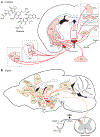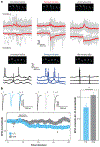Oxytocin, Neural Plasticity, and Social Behavior
- PMID: 33823654
- PMCID: PMC8604207
- DOI: 10.1146/annurev-neuro-102320-102847
Oxytocin, Neural Plasticity, and Social Behavior
Abstract
Oxytocin regulates parturition, lactation, parental nurturing, and many other social behaviors in both sexes. The circuit mechanisms by which oxytocin modulates social behavior are receiving increasing attention. Here, we review recent studies on oxytocin modulation of neural circuit function and social behavior, largely enabled by new methods of monitoring and manipulating oxytocin or oxytocin receptor neurons in vivo. These studies indicate that oxytocin can enhance the salience of social stimuli and increase signal-to-noise ratios by modulating spiking and synaptic plasticity in the context of circuits and networks. We highlight oxytocin effects on social behavior in nontraditional organisms such as prairie voles and discuss opportunities to enhance the utility of these organisms for studying circuit-level modulation of social behaviors. We then discuss recent insights into oxytocin neuron activity during social interactions. We conclude by discussing some of the major questions and opportunities in the field ahead.
Keywords: hypothalamus; maternal care; neural circuits; neuromodulation; social behavior; social bonding.
Figures





References
Publication types
MeSH terms
Substances
Grants and funding
LinkOut - more resources
Full Text Sources
Other Literature Sources

